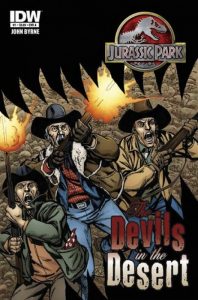It’s been the inclination of most “Jurassic Park” comics that old characters and new dinosaur species are the key to success. But the opposite approach – new characters and old dinosaur species – has produced the best comics, first with Topps’ “Return to Jurassic Park” Issues 5-8 and more recently with IDW’s four-issue “The Devils in the Desert” (2011).
“Devils in the Desert” is written and drawn by John Byrne, a comics legend whose work I have admired on other franchise efforts like “Aliens: Earth Angel” and “Angel: Blood & Trenches.” Byrne writes easy-to-follow stories with twists and surprises. His characters are clearly and broadly drawn, but with enough room for subtleties like romantic attraction, as is the case between paleontologist Dr. Monica Alvarez and Sheriff Will Tobias.
While some “JP” comics throw dinosaurs and the word “ROAR” all over the page in attempt to create mayhem, Byrne understands that what works in movies doesn’t necessarily work in comics, so he leaves a lot of the scares off-panel and to the imaginations of readers. Set in the southern California desert, “Devils” is a slow-burn horror story with ranchers, rural law enforcement, hikers and hunters. Byrne also peppers in the FBI and InGen officials, who walk the fine line of protecting their interests while claiming no responsibility for the pteranodon attacks.
Byrne does his research into the “JP” mythos. “Devils’ ” four covers feature what appears to be the silhouette of a toothsome T-rex, but the end of Issue 1 reveals the beast to be a pteranodon (or rather a whole nest of them). Byrne was no doubt inspired by the end of “Jurassic Park III,” when Grant notes the airborne pteranodons are searching for a new nesting ground. While that movie — and “The Lost World,” which likewise closed with a shot of pteranodons flying free – played up the prehistoric beauty of the beasts, “Devils” finally acknowledges the serious threat they pose.
InGen official: “I did warn John Hammond it was less than the best idea to create things with wings. If anything was going to get off one of those islands without our help, the pteranodons would top the list.”
But pteranodons, even those in “JP III,” don’t have teeth. “Devils’ ” Alvarez (the series’ breakout character), makes note of this, and thinks she has an explanation. Rightly assuming that these creatures came from InGen’s islands, she says:
“These aren’t prehistoric animals. I saw Alan Grant give a lecture a few years back. He called them genetically engineered theme park monsters. And that’s what they are!”
Like many “JP” yarns, “Devils” acknowledges that these aren’t dinosaurs in a scientific sense, but at the same time imagines that they are indeed dinosaurs in a broad sense: Alvarez’s theories about pteranodon nesting behavior prove useful.
Since Grant’s “JP III” lecture was in 2001, Alvarez’s statement places “Devils” in 2004, just before “Redemption,” which takes place just before the public opening of Jurassic Park in 2005. (June’s “Jurassic World” – which, like “Devils,” features no major characters from the original three films — tells us the park has been open for 10 years.)

“Devils” proves pteranodons have a lot of mileage left after their breakout turn in “JP III,” as they slaughter horses, cattle and humans, and take on airplanes, big military weapons … and in a great showdown between prehistoric and modern beast — a polar bear.
By not trying to do too much with the mythology or core characters, Byrne creates the most satisfying “JP” comics yarn up to this point, and one that would work well as a movie if the franchise wanted to try a less world-shattering story. It’s a good old-fashioned rural horror story that just happens to feature flying dinosaurs.

